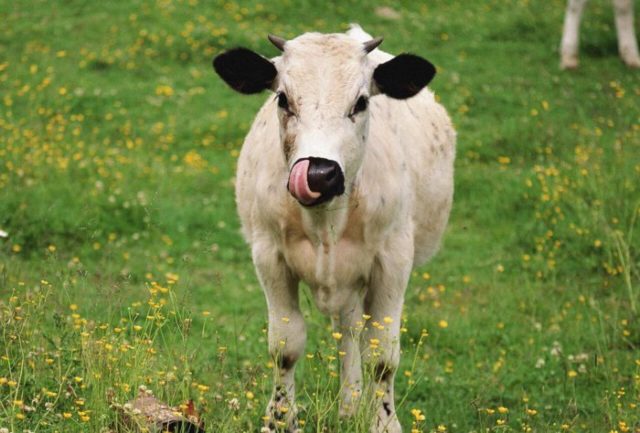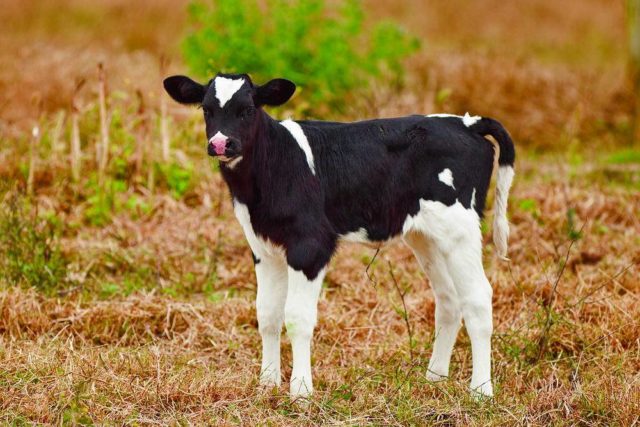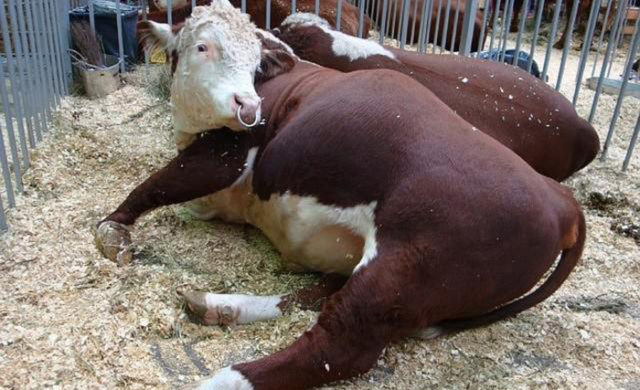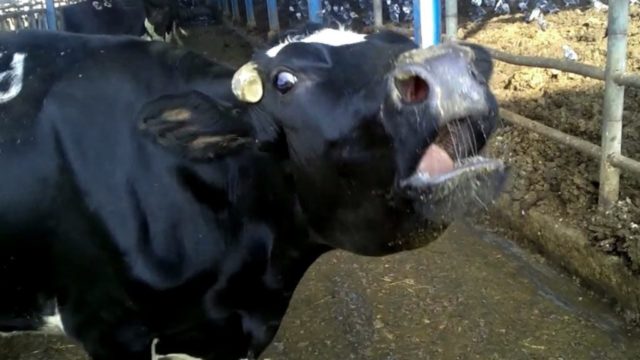Content
In modern society, there is an interesting stereotype: if an animal has foam at the mouth, it is mad. In fact, the clinical symptoms usually differ from the mass perception of the disease. There are other reasons as well. If the calf has foam at the mouth, it is not rabid, it has serious problems with the digestive system.
Several reasons why a cow is foaming at the mouth
In fact, there is no single reason why a calf can get froth in the mouth. In some diseases, salivation occurs. But due to the abundant salivation, the restless behavior of the calf, the constant chewing movements, the saliva goes into foam. Moreover, this usually happens when the disease has already started and treatment is late.
In theory, foam in the mouth can occur for the following reasons:
- stomatitis;
- poisoning;
- tympany;
- inflammatory processes in the gastrointestinal tract;
- blockage of the esophagus.
But all these problems begin much earlier than the foam appears. If you closely monitor the calves and notice changes in their behavior, it is unlikely that it will come to foam.

There are enough plants in the meadows that can cause poisoning or burn the mouth of a calf
Stomatitis
Inflammatory process on the oral mucosa. Occurs due to local exposure to irritants. It can be primary and secondary. Primary stomatitis are:
- biological;
- thermal;
- chemical;
- mechanical.
The type depends on the type of damaging factor. Secondary stomatitis occurs with diseases of the stomach or pharynx. May be a symptom of an infection.
Mechanical stomatitis occurs due to damage to the oral cavity by foreign hard objects or improper erasure of teeth. The easiest and safest type of disease. It is enough to file the teeth, exclude roughage and make sure there is no debris in the pasture to remove the cause of the disease. Wounds in the mouth are treated by washing them with disinfectant solutions.
Chemical and thermal stomatitis often occurs due to improper administration of medications or feeding too hot food (bran brewed with boiling water in winter). Chemical causes can be:
- too concentrated hydrochloride, acetic acid or gallstone;
- poisonous burning plants;
- licking by the calf of warming ointments from other parts of the body.
Here it is sometimes difficult to eliminate the cause, but this type of stomatitis also does not pose a particular danger.
Secondary, which is a symptom of another disease, is one of the most difficult. You cannot get rid of them until the true cause is eliminated.
There is no foam in the mouth on the list of signs of any stomatitis. Even profuse salivation is not the most characteristic symptom of the disease. But there is foam in calves. This is not a symptom - it is a consequence of pain. Animals tend to lick troublesome wounds. Saliva churns into foam as the calf constantly chews and moves its tongue to relieve pain.

Since one of the signs of foot and mouth disease is stomatitis, the appearance of foam in the mouth is possible due to the "restless" tongue.
Poisoning
There are two reasons for the appearance of foam in case of poisoning:
- chemical stomatitis;
- foam from the nose, as a symptom of poisoning with certain plants and substances.
With severe intoxication, foam can go not only from the nose, but also from the mouth.
Symptoms of poisoning are different and depend on the action of the poison.Possible excitation and inhibition of the central nervous system, salivation and dryness of the mucous membranes. The most common symptom is diarrhea. But even diarrhea is not always the case.
Not foam, but saliva appears when poisoning with compounds:
- copper;
- barium;
- arsenic;
- lead;
- chlorine;
- mercury;
- nitrophenol;
- calbamic acid;
- alkalis;
- urea.
In case of poisoning with all these substances, foam appears already in the pre-agonal state, when the calf does not control muscle movements.
Many poisonous plants cause profuse salivation. The foam is not indicated anywhere in the symptoms. But this does not mean that it will definitely not be there. As with stomatitis, it can appear if the calf is actively working with its jaws and tongue. Drooling and, possibly, foam in the mouth can appear in case of poisoning with "honest" food. If the nitrate norm is exceeded in the products. This symptom is also typical for feeds that form:
- mustard oil (rapeseed, field mustard, camelina and others);
- solanine (green or sprouted potatoes);
- hydrocyanic acid (wild clover, vetch, sorghum, flax, mannik and others);
- copper (soy and bean cakes).
Feed is more likely to become toxic if stored improperly.

The development of diarrhea in a calf with poisoning is much more likely than foaming at the mouth.
Salt poisoning
The only type of intoxication in which foam in the mouth is a "legitimate" symptom. The lethal dose of salt for cattle is 3-6 g / kg of live weight. For this reason, it is undesirable to feed the calves with salt. Much better to hang a lick. The animals themselves will lick off the salt as much as they need.
The course is always acute. Intoxication occurs within 30 minutes after consuming excess salt. Symptoms of sodium chloride poisoning:
- loss of appetite;
- dyspnea;
- vomiting is possible;
- dilated pupils;
- excitation;
- aimless movement.
With the further development of intoxication, diarrhea develops, general weakness increases. Muscle tremors and cyanosis of the mucous membranes appear. Further, with salt poisoning, one can observe convulsions similar to epileptic ones. At the same time, foam appears in the mouth. But in this case it is only a consequence of the "whipping" of saliva due to the movements of the tongue and jaws uncontrolled by the calf. The animal dies a few hours after the onset of the first symptoms from asphyxia.
Survival depends on timely assistance provided:
- gastric lavage several times;
- intravenous infusion of calcium chloride at the maximum dose and glucose with caffeine.
Calcium chloride can be replaced by intramuscular administration of calcium gluconate.
Bloating
So in cows, tympania is usually called. The release of gases in the rumen is not always combined with the foaming of the contents of the proventriculus. More often, only gas formation occurs, which saves the lives of a large number of calves. Foamy tympania is more dangerous for animals.
Since there is no belching during tympanum, the appearance of foam in the mouth of the calf means that the rumen is overflowing with fermenting contents. The appearance of this mass in the mouth of a cow means a weakening of the sphincter and a very poor condition of the animal.

The owner must have a special "talent" to bring the development of tympania to the appearance of foam in the mouth
Qatar of the gastrointestinal tract
Previously, the word "catarrh" was called almost any disease of the gastrointestinal tract, from gastritis to ulcers and viral enteritis. Today the term is almost out of use. Instead, more specific types of diseases are usually named. There is only one thing that unites various diseases: an inflammatory process that affects the mucous membranes of the gastrointestinal tract.
Foam in the mouth is not on any list of catarrh symptoms. But diarrhea is often found in various variations: from watery to bloody.
Blockage of the esophagus
Foam is also not included in the list of symptoms.If the esophagus is incompletely blocked, the calf can swallow saliva and water, but cannot eat. When full - the animals do not eat, they are worried. They cannot swallow saliva, and it flows out. The belching stops and tympania develops. Cows make swallowing movements, trying to push the foreign object.
Foam can form precisely when trying to push out the obstacle with the help of swallowing movements. Even with an incomplete blockage, the calf moves its tongue and jaw to get rid of the blockage in the esophagus.

The characteristic position of the head in a cow with a blockage of the esophagus, thanks to the active work of the jaws and tongue, soon the animal will also have foam
Foam at the mouth of a calf
Call your veterinarian immediately. It will be very lucky if the appearance of foam is associated with stomatitis. However, even this problem may turn out to be only a symptom of a more serious illness. The appearance of foam in the mouth during poisoning means severe intoxication, when the calf can be pumped out only with the help of intensive therapy and droppers.
Worst of all, if it turns out to be a fermented mass from the rumen. Although belching is normal for cows, belching stops when there is a health problem. The appearance of frothy vomiting in the mouth of the calf means that the sphincters have begun to weaken and the animal is most likely in a pre-agonal state.
However, this may also be due to the fact that the owners prefer to seek free help on the forums. Until the owner receives answers, analyzes information, or conducts experiments on the calf, time will be lost. The veterinarian will come when the disease has already started. Therefore, first of all, you need to call the veterinarian.
Prevention measures
All diseases in which the calf has foam at the mouth are somehow related to the diet. The exception is infectious and viral diseases. But even here the resistance of animals is higher if they receive adequate nutrition. Therefore, first of all, prevention is high-quality feed and the absence of poisonous plants in grazing. Next in importance are vaccinations against diseases, in the list of symptoms, which include:
- stomatitis;
- gastritis;
- inflammation of the gastrointestinal mucosa.
Good living conditions also help to strengthen the immune system. Otherwise, the prevention of foam depends on the cause of this phenomenon. It may be necessary to check the pastures for inedible items, and clean the farm area of mineral poisons.
Conclusion
Foam at the mouth of a calf is a very alarming sign showing the last stage of the disease. It makes no sense to ask on forums and social networks "why does my calf have foam", you need to look at other signs of the disease. Foam is not a symptom. This is a sign of the final stage of the disease.








